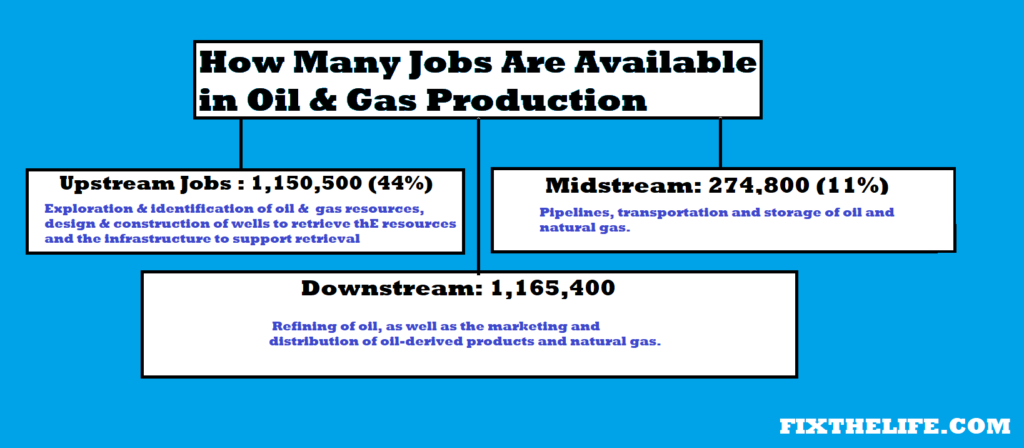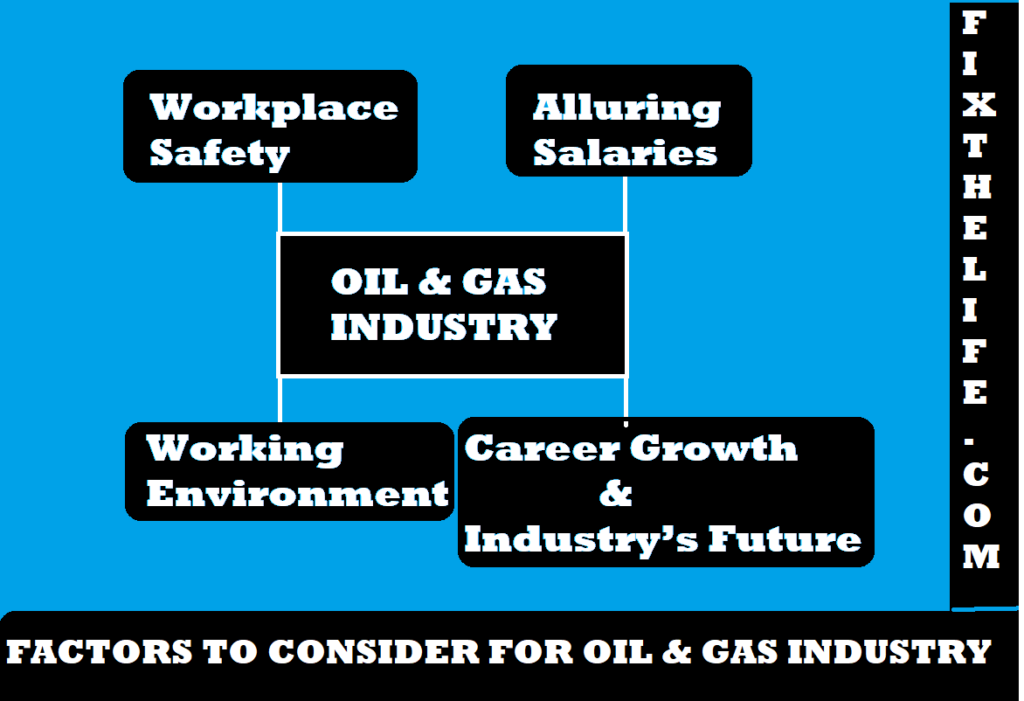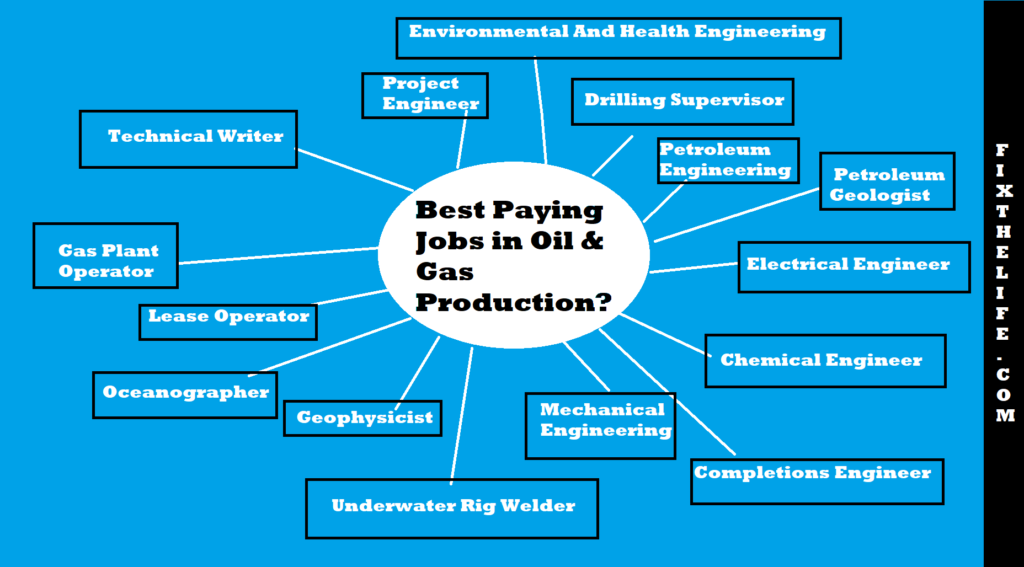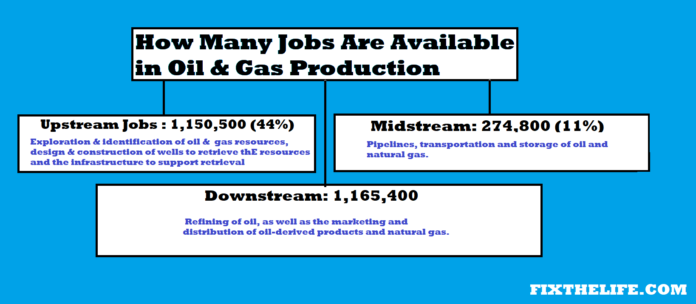How Many Jobs Are Available in Oil & Gas Production
How Many Jobs Are Available in Oil & Gas Production – Many people ask this question in emails to our experts. Jobs in oil & gas production are lucrative and offer several other benefits over regular jobs. Today we will look deeper at the jobs available in oil & gas production industry.
The oil & gas industry is a thriving sector of the global economy, supporting numerous high-paying jobs. With traditional sources coming from countries such as Saudi Arabia and Iraq and breakneck growth from advanced drilling techniques in North Dakota and Texas, there are more opportunities than ever to get into this lucrative field.
For individuals seeking new career pathways or looking for their next challenge in energy production, FixTheLife can help provide that pathway forward.
The energy industry is booming in America, with the National Association of State Energy Officials estimating a 4.6% increase over 2017 – that’s an additional 151,700 workers employed.
This now makes up nearly 7 million individuals across electric power generation and transmission distribution sectors, motor vehicles, and energy efficiency services. Clearly, this sector has proven essential for powering U.S. economic growth.
How Many Jobs Are Available In Oil & Gas Production?
According to an API study from 2017, the U.S. oil and gas industry has risen as a leader in global production. But this is not all – it provides gainful employment for 10.3 million Americans.
The number of jobs supported by the sector even reached 500,000 more positions since 2011; those are significant figures that symbolize economic growth and stability within our nation’s borders.
Gazprom, the world’s leading oil and gas business, boasts an impressive 477,600-strong workforce. As one of today’s biggest employers worldwide in 2021, it continues to drive innovation in its industry.
PetroChina firmly secures second place- the employer of 432,000 workers -while Sinopec (China) places third with 384,070. Rosneft follows close behind in the fourth spot – boasting an impressive 334,600 personnel across their oil and gas industry operations.
Oil and Gas Industry Employment Statics

With a global reach, the oil and gas industry offers important employment opportunities to millions worldwide. By understanding its impactful scale through these key statistics, we can gain insight into this thriving workforce sector.
Oil rigs are expansive pieces of engineering that require experienced, specialized personnel to operate.
From experts in advanced machinery and safety protocols with years of industry experience down to laborers just getting their start in the energy sector, oil rig workers come from a wide range of backgrounds.
These important positions offer a median hourly wage of $24 across both onshore and offshore drilling sites – making them an attractive step into professional career paths around America.
The petroleum industry is a major powerhouse for the global economy, with Middle Eastern nations like Saudi Arabia and Iraq leading production alongside other powerhouses such as Russia, Canada, and the U.S.
This sector holds tremendous influence in worldwide markets due to its importance on economic growth.
The global workforce has recently experienced an unprecedented level of job insecurity due to the pandemic. These changes have particularly impacted professionals in this industry as they grapple with instability and a lack of long-term prospects.
Uncover astonishing insights into the oil and gas industry, learning more about its remarkable reach and impact on our lives.
Oil & Gas Industry Employment Trends
- The oil and gas industry in the U.S. employs around 10.3 million people, with 6.7 million Americans working in the energy field.
- The global oil and gas market size is estimated to reach $5,870.13 billion in 2021, with Gazprom being the world’s leading oil and gas company with 477,600 employees.
- 51% of the oil produced in America comes from hydraulic fracturing jobs that have an average salary of $52,202 per year, while rig workers make a median hourly wage of $24
How Many Jobs Are Available In Oil & Gas Production
Is oil & gas production a good career path?
The oil and gas industry is an attractive career option, offering generous wages that reflect the highly-specialized skills needed to succeed. With a solid educational background behind you, entry into this sector can open up doors of opportunity — financial and otherwise.
How much employment does the oil industry offer?
By 2022, 324,319 Americans will be employed in the Oil Drilling & Gas Extraction industry. This provides ample opportunity for ambitious and hardworking individuals to gain meaningful employment across the country.
Is working in the oil field a good idea?
Oil fields can offer rewarding wages to those willing to do the hard work needed for crude oil extraction.
If you are looking for a career where your skills and experience come into play, exploring what positions exist within the industry could help you discover if working with oil is the right choice.
General Oil and Gas Industry Employment Statistics
The current statistics state that the U.S. oil & gas industry offers employment to nearly 10.3 million people.
The U.S. oil and natural gas industry continue to be an essential contributor to the American workforce.
An API study in 2017 found that this sector has provided 10.3 million jobs, representing a remarkable increase of 500,000 new positions since 2011 – a testament to how key this vital energy source is for our country’s prosperity.
Joe Biden’s clean energy proposal is set to cause major disruption, as 6.5% of the U.S.’ total jobs and an entire oil and gas sector could be eliminated in its wake. This plan will push America forward into greener pastures – but at what cost?
The global oil & gas market cap topped $5,870.13 billion in 2021.
The oil and gas industry has experienced immense growth to reach a market size of $5,870.13 billion in 2021 at an impressive CAGR of 25.5%. Globalization has played its part as this dynamic sector continues to expand yearly.
Despite tremendous setbacks from the pandemic, oil and gas companies continue to persevere.
As a result of restrictive lockdowns worldwide which led to social distancing, remote working, and business closures – an unprecedented roadblock was placed in front of this industry’s growth, yet they persist as global conditions evolve.
Despite current market conditions, the oil industry is projected to reach an impressive $7.4 trillion in 2025 – thanks to a sturdy 6% compound annual growth rate.
The energy field employs nearly 6.7 million U.S. citizens.
The American energy sector has seen substantial growth in the last two years, with 151,700 additional jobs created. The energy industry now makes up 4.6% of the overall U.S. workforce and encompasses electricity generation/transmission/distribution as well as motor vehicle production and efficiency initiatives.
The energy sector continues to prove its strength as a reliable job creator, contributing substantially towards creating approximately 7% of all new jobs in the country.
Gazprom employs 477,600 people, making it the leading oil and gas company on Earth.
Gazprom controls the world of oil and gas, dominating 2021 with a workforce totaling more than 477 thousand. PetroChina is its closest competitor, boasting 432k employees in second place, while Sinopec (China) comes third at 384 thousand.
Rosneft sits further back on the fourth spot but still commands respect among competitors — 334 thousand staff strong forged from this powerful industry.
IOGP’s data reported an impressive decrease in the Total Recordable Injury Rate (TRIR) for 2019.
This 0.07 drop from 2018 reinforces that industry-wide health and safety is improving substantially yearly, with a steady TRIR of approximately 0.92 per million work hours now firmly on the map.
In the year surveyed, 703 incidents were reported by IOGP members – 551 of those attributed to contractors and 152 linked back to oil & gas companies.
America’s daily demand for oil barrels in 2020 was 18.12 million.
Despite the U.S.’s significant contribution to oil and gas production, only a tiny fraction is used domestically.
With the U.S. at the helm of global oil consumption, one wonders how much it takes for America to satisfy its appetite. How big is this figure? Let’s take a look.
Despite the oil industry experiencing an unprecedented decline due to COVID-19, U.S. petroleum consumption in 2020 hit a record low since 1995.
With 18.12 million barrels consumed each day and 6.63 billion per year – evidence of significantly reduced demand for oil over the last year has been revealed as we experience firsthand its devastating impacts on our world economy.
What are the Types of Jobs in the Oil & Gas Industry?
If a career in the oil and gas industry interests you, you may be curious to know what opportunities are available.
The valuable energy market heavily influences global economics, so expertise is essential for working within this sector.
Often requiring extensive knowledge of complex operations associated with extracting and distributing oil resources worldwide – it’s no surprise that these specific roles must meet rigorous standards.
Benefits of Oil & Gas Jobs

Statics on Fracking
The fracking job’s average salary is $62,976
Fracking is a double-edged sword. On the one hand, it can help us access precious fuel resources beneath the surface of our planet; on the other.
Fracking must be done right to protect vulnerable aquifers, water sources, and wildlife habitats from potential contamination or destruction due to its mix of explosive elements and chemicals.
The regulation governing fracking needs to keep up with technological advances for everyone — humankind included — to benefit sustainably from this method while preserving nature’s delicate balance at all times.
Fracking is a booming job market offering salaries ranging from nearly six figures to mid-$50K.
However, due to the ever-changing nature of this industry, it’s tough for employers or employees to get an exact handle on potential earning power – with Glassdoor estimating average promised wages topping out around $62,976 at present.
If the fracking sector gets banned, it can affect 14.8 million jobs in the U.S.
Without the hydraulic fracturing industry, U.S. prosperity could be dramatically diminished due to its vast economic implications. Closing this vital sector would lead to catastrophic consequences for our nation and citizens.
The Global Energy Institute has posed a pressing and thought-provoking question: what ramifications await our job market? Should fracking be prohibited? Explore this issue in their latest report.
By 2022, fracking is estimated to save a stunning 15 million jobs in the U.S. alone. Without it, energy costs would skyrocket – Americans could face an extra $4k annually to make ends meet.
The hydraulic fracturing industry completes nearly half of the U.S. oil production.
By 2015, U.S. Energy Information Administration data revealed a remarkable rise in the total number of hydraulically fractured wells to 300,000. Accordingly, these dynamic production sources contribute 51% of America’s overall oil output.
Fracking is a major player in the U.S. energy industry, providing an impressive 67% of all American gas production.
Oil and Gas Employment Statistics – Best Careers in the oil and gas Production industry

With the ever-growing energy demand, lucrative opportunities abound in oil and gas Production. Roles such as Field Technicians, Welders, Roustabouts, and Operators are highly sought after – offering competitive pay to those eager to pursue a career in this booming industry.
An oil rig worker’s median hourly wage in the U.S. is $25.
Oil rigs are intricate machines that require the skill and expertise of engineers, laborers, and managers to function properly. With different backgrounds ranging from education levels to certifications, oil rig ‘teams’ come together both onshore and offshore with one goal: To uncover valuable resources below Earth’s surface safely.
Those willing to take the risk of working on an oil rig can be assured that it is one of the most rewarding professions in terms of wages.
In July 2021, figures suggested a salary between $18 and $34 per hour – with the average sitting close to the median at around twenty-five dollars each.
A field worker’s average salary is $40,000
The oil field industry is highly rewarding, with salaries varying depending on the particular occupation.
With high employment demand always on the table, there are plenty of opportunities for those looking to enter this sector – from maintenance workers and supervisors to entry-level machine operators and laborers.
With a wage of approximately $21 per hour, many oil field workers enjoy an annual salary well above the median household income in America today – around $40,000 yearly.
Talent.com determined this figure from over 400 salaries shared by those currently working in this industry and is indicative of how rewarding professions within can be for individuals looking to earn meaningful paychecks and pursue gainful employment opportunities.
The average salary for oil & gas industry accountants is $74,063
Oil and gas accountants are well-compensated, with salaries ranging from around $57K per year for entry-level positions to almost double that amount – a lucrative $87.5K – at the high end.
The average oil and gas accountant takes home an impressive annual income of approximately 68 thousand dollars or 35 bucks an hour.
A project manager is one of the best-paying jobs in oil & gas production, with an average of $157,795
Despite its tumultuous history, the oil and gas industry remains an attractive option for job seekers searching for high-paying roles.
Management positions are particularly lucrative, providing a rewarding career path with competitive compensation at every level.
Project managers in the oil and gas industry are essential for keeping operations on track, so it’s no surprise their annual salaries rank among the highest.
Companies know that top performance is worth every penny of a project manager’s $157,795 salary – because they keep complex projects running smoothly from start to finish.
Supervising drillers stand at the helm of one of today’s most lucrative careers, boasting an impressive annual salary averaging around $148K.
Meanwhile, construction managers still hold steady six figures despite fluctuating market conditions for oil and gas operations executives.
A Petroleum engineer can earn an average of $94,000 per year.
Contrary to stereotypical belief, college majors other than a traditional business, computer science, or mathematics can lead to a highly paid career.
In fact, according to PayScale’s report, Petroleum engineering is one of the most lucrative paths with an impressive salary potential.
Gas and oil engineering salaries are often dynamic, depending on how much expertise a worker brings.
Starting in this field can yield an exciting starting salary of around $94k per year – but with experience, there’s even greater potential, up to an average yearly compensation of $175K.
Chemical Engineer– Average Salary: $105,550 Annually
As a chemical engineer, you exercise your expertise to ensure that crude oil is effectively converted into usable resources. Utilizing the right chemicals and processes can create valuable products such as gasoline from this natural resource.
An invaluable assessment is needed to unleash the potential of raw petroleum deposits. Through careful evaluation, valuable products can be extracted from these resources by understanding the complete process.
Petroleum Engineer – Average Salary: $81354 Annually.
A petroleum engineer plays an important role in keeping up with the fossil fuel industry.
Their work involves collaborating closely with geologists and scientists to develop promising drilling strategies while also ensuring safe working conditions for their team.
This critical position is responsible for establishing innovative methods that allow us to responsibly access our oil and gas reserves.
Oil and gas accountant
Oil and gas accountants are a vital part of the energy industry, using their skills to help production companies manage finances.
From preparing balance sheets to tracking budgets, they ensure every penny is allocated correctly while helping organizations comply with tax regulations.
Electrical Engineer – Average Salary: $87382 annually.
Electrical engineers are the backbone of oil and gas production, designing complex machinery to ensure everything from installation to maintenance runs optimally. With their expertise, operators could secure efficient fuel resources for our world’s energy needs.
Electrical engineers are essential for power grids to run smoothly, providing the energy backbone of oil and gas production. Keeping everything running requires careful monitoring and design from these dedicated professionals.
Oil Rig manager
Rig managers are an integral part of the oil-drilling sector, ensuring operations and personnel run smoothly.
They foster a safe environment for workers in various locations by overseeing crews drilling at active sites while monitoring policies and procedures to guarantee long-term success.
Surveyor
Oil and gas surveyors are integral members of the energy industry, playing a vital role in researching potential sources of fuel.
They use their knowledge of offshore locations to identify oil resources while interpreting data related to discoveries and producing comprehensive reports for clients on-site and at sea.
Well testing operator
Well-testing operators are the engine that drives oil drilling projects forward, responsible for location setup, safe operations, and quality control of crucial flow-back procedures.
Their expertise gets even the most ambitious drills up and running quickly – their work is paramount to a successful job done right.
Petroleum Geologist – $111,667 Annually
Geologists in the oil and gas industry collaborate with teams to evaluate seismic imaging data, utilize sedimentary techniques and stratigraphy, as well as assess pre-existing drill hole information.
With this combined approach, they analyze rocks deep below Earth’s surface – unlocking potential sources of natural gas or crude oil deposits.
Foreperson
As an essential part of the oil and gas industry, Foreperson ensure successful extractions by managing operations at well sites.
They skillfully deploy advanced drilling tools to enable extraction processes and vigilantly inspect equipment for optimal functionality.
Completions Engineer – Average Salary $139,213 per year
As an oil & gas completions engineer, you will oversee the completion of a well’s assembly and ensure it is correctly functioning for pumping.
You must monitor wells closely to identify any potential issues which could impede progress and devise strategies that enable the installation of additional equipment efficiently.
It takes focus, creativity, and foresight – everything essential to finish this important job optimally. Completions Engineer is one of the best-paying jobs in the oil & gas industry.
Offshore Technician
Offshore technicians help power the oil and gas industry, working to install, assess and maintain equipment used for offshore drilling.
With expertise from mechanical maintenance to process operations, these professionals play an essential role in keeping vital energy production running smoothly.
Oil and Gas Employment in Different States
Texas state lost approximately 60,000 oil and gas jobs in 2020.
The coronavirus pandemic has dealt a big blow to the oil industry, with 60,000 Texans being displaced from their jobs in 2020 alone. This unfortunate development magnifies ongoing economic woes within this essential sector of the U.S. economy.
With economic uncertainty brought on by the pandemic, the oil and gas industry was heavily affected.
This led to a decrease in drilling activities of more than 25%, leading many companies to make significant cuts – including various redundancies across Texas’s employment sector.
Despite an ongoing economic crisis caused by the global pandemic, 150,000 upstream oil and gas employees in Texas have managed to remain employed—a significantly lower figure than we’ve seen over recent years.
Wyoming is the second-largest producer of natural gas after Texas.
Wyoming is a prime example of the current oil and gas industry, boasting 38,000 active wells across 20 counties.
2020 saw the most activity in the Niobrara Shale play, which accounts for many jobs throughout Wyoming, making it one of the seventh-largest and second-biggest natural gas producers nationwide.
Louisiana state employs 300,000+ jobs in the oil and gas sector.
Boasting a place in the top ten U.S. states for oil and gas production, Louisiana is powering its economy with more than 300,000 positions that are directly or indirectly supported by this lucrative industry.
The U.S. oil and gas industry is poised for tremendous growth in the years ahead, with advanced drilling techniques enabling companies to explore and exploit new energy resources.
This year’s employment statistics reflect an expanding field that will continue its progress into 2021 and beyond.
Things to Learn from the Oil and Gas Industry Employment Statistics?
Despite an unprecedented slowdown in oil and gas production caused by the pandemic, these industries remain critical to our global economy.
While demand for healthier energy alternatives has been bolstered due to current challenges, key players within this sector continue to benefit from natural resources like petroleum and natural gas – suggesting that job opportunities are still very much available.
The oil and gas industry has the potential to provide lucrative financial benefits. However, it poses a higher danger level for workers due to inadequate safety protocols.
As such, extensive measures must be taken in order to protect those employed within this sector from preventable fatalities.
How Many Jobs Are Available in Oil & Gas Production – Final Words
We tried our best to answer your question, “How Many Jobs Are Available in Oil & Gas Production” I hope you are now satisfied and looking forward to checking the best-paying jobs in oil and gas production.
Other Career Paths
Is Integrated Oil Companies a Good Career Path? Best Jobs in Integrated Oil and Gas Industry
Best Paying Jobs In Integrated Oil Companies
IS REAL ESTATE INVESTMENT TRUSTS A GOOD CAREER PATH?
The BEST PAYING JOBS IN REAL ESTATE INVESTMENT TRUSTS
How Many Jobs are Available in Real Estate investment Trusts
Best Paying Jobs in Major Banks in 2023 – Highest Paying Bank Jobs
25+ Best Paying Jobs in Oil & Gas Production – Oil Field Jobs
Is Oil & Gas Production A Good Career Path?
How Many Jobs are Available in Consumer Services : Complete Guide
IS CONSUMER NON-DURABLES A GOOD CAREER PATH IN 2023
How Many Jobs are Available in Consumer Non-durables
THE BEST PAYING JOBS IN MISCELLANEOUS IN 2023 🧑💼




